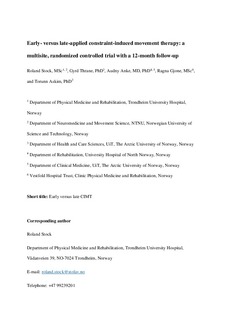| dc.contributor.author | Stock, Roland | |
| dc.contributor.author | Thrane, Gyrd | |
| dc.contributor.author | Anke, Audny | |
| dc.contributor.author | Gjone, Ragna Ingeborg | |
| dc.contributor.author | Askim, Torunn | |
| dc.date.accessioned | 2017-10-02T09:17:00Z | |
| dc.date.available | 2017-10-02T09:17:00Z | |
| dc.date.created | 2017-07-11T11:12:00Z | |
| dc.date.issued | 2017 | |
| dc.identifier.citation | Physiotherapy Research International. 2017, . | nb_NO |
| dc.identifier.issn | 1358-2267 | |
| dc.identifier.uri | http://hdl.handle.net/11250/2457654 | |
| dc.description.abstract | Background and Purpose: A direct comparison between the effects of constraint-induced movement therapy (CIMT) applied early after stroke and that of CIMT applied in the chronic phase has not been conducted. This study aimed to compare the long-term effects of CIMT applied 6 months after stroke with the results of CIMT applied within 28 days post-stroke.
Methods: This study was a single-blinded, multicenter, randomized controlled trial with a crossover design. Forty-seven patients received CIMT either early (within 28 days) or 6 months after stroke. Both groups received standard rehabilitation and were tested at five time points. The primary outcome measure was Wolf Motor Function Test (WMFT); the secondary measures were Nine-Hole Peg Test (NHPT), the Fugl-Meyer Assessment (FMA) of the upper extremity, Stroke Impact Scale, and Modified Rankin Scale (MRS).
Results: Compared with baseline data, both groups showed significant improvements in the primary and secondary outcome measures after 12 months. No significant differences between the two treatment groups were found before and after the delayed intervention group received CIMT at 6 months and during the 12-month follow-up. Both groups recovered considerably and showed only minor impairment (median FMA score of 64) after 6 months. The early intervention group showed an initially faster recovery curve of WMFT, NHPT, and MRS scores.
Discussion: In contrast to most CIMT studies, our study could not find an effect of CIMT applied 6 months after stroke. Our results indicate that commencing CIMT early is as good as delayed intervention in the long-term, specifically in this group of patients who might have reached a ceiling effect during the first 6 months after stroke. Nevertheless, the early CIMT intervention group showed a faster recovery curve than the delayed intervention group, which can be a clinically important finding for patients in the acute phase. | nb_NO |
| dc.language.iso | eng | nb_NO |
| dc.publisher | Wiley | nb_NO |
| dc.title | Early versus late-applied constraint-induced movement therapy: A multisite, randomized controlled trial with a 12-month follow-up | nb_NO |
| dc.type | Journal article | nb_NO |
| dc.type | Peer reviewed | nb_NO |
| dc.description.version | acceptedVersion | nb_NO |
| dc.source.journal | Physiotherapy Research International | nb_NO |
| dc.identifier.doi | 10.1002/pri.1689 | |
| dc.identifier.cristin | 1481874 | |
| dc.relation.project | Helse Nord RHF: SAT 544‐06 | nb_NO |
| dc.description.localcode | This is the peer reviewed version of the following article: Early versus late-applied constraint-induced movement therapy: A multisite, randomized controlled trial with a 12-month follow-up, which has been published in final form at https://doi.org/10.1002/pri.1689. This article may be used for non-commercial purposes in accordance with Wiley Terms and Conditions for Self-Archiving. LOCKED until 7.7.2018 due to copyright restrictions. | nb_NO |
| cristin.unitcode | 194,0,0,0 | |
| cristin.unitcode | 194,65,30,0 | |
| cristin.unitname | Norges teknisk-naturvitenskapelige universitet | |
| cristin.unitname | Institutt for nevromedisin og bevegelsesvitenskap | |
| cristin.ispublished | true | |
| cristin.fulltext | postprint | |
| cristin.qualitycode | 2 | |
